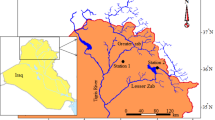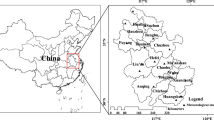Abstract
Drought over Southwest China occurs frequently and has an obvious seasonal characteristic. Proper management of regional droughts requires knowledge of the expected frequency or probability of specific climate information. This study utilized k-means classification and copulas to demonstrate the regional drought occurrence probability and return period based on trivariate drought properties, i.e., drought duration, severity, and peak. A drought event in this study was defined when 3-month Standardized Precipitation Evapotranspiration Index (SPEI) was less than −0.99 according to the regional climate characteristic. Then, the next step was to classify the region into six clusters by k-means method based on annual and seasonal precipitation and temperature and to establish marginal probabilistic distributions for each drought property in each sub-region. Several copula types were selected to test the best fit distribution, and Student t copula was recognized as the best one to integrate drought duration, severity, and peak. The results indicated that a proper classification was important for a regional drought frequency analysis, and copulas were useful tools in exploring the associations of the correlated drought variables and analyzing drought frequency. Student t copula was a robust and proper function for drought joint probability and return period analysis, which is important for analyzing and predicting the regional drought risks.








Similar content being viewed by others
References
Abolverdi J, Khalili D (2010) Probabilistic analysis of extreme regional meteorological droughts by L-moments in a semi-arid environment. Theor Appl Climatol 102:351–366
Cancelliere A, Salas JD (2004) Drought length properties for periodic-stochastic hydrologic data. Water Resour Res 40:W02503. doi:10.1029/2002WR001750
Chen L, Singh VP, Guo SL Drought Analysis based on copulas. In: 2011 Symposium on Data-Driven Approaches to Droughts, 2011
De Michele C, Salvadori G (2003) A generalized Pareto intensity-duration model of storm rainfall exploiting 2-copulas. Journal of Geophysical Research: Atmospheres (1984–2012) 108: 4067 doi:10.1029/2002JD002534
Fernández B, Salas JD (1999) Return period and risk of hydrologic events I: Mathematical Formulation. J Hydrol Eng 4:297–307
Hao C, Zhang J, Yao F (2015) Combination of multi-sensor remote sensing data for drought monitoring over Southwest China. Int J Appl Earth Obs Geoinformation 35:270–283
Hosking J, Wallis J (1993) Some statistics useful in regional frequency analysis. Water Resour Res 29:271–281
Hosking JRM, Wallis JR (2005) Regional frequency analysis: an approach based on L-moments. Cambridge University Press, Cambridge
Joe H (1997) Multivariate models and multivariate dependence concepts vol 73. CRC Press, Florida
Kao SC, Govindaraju RS (2008) Trivariate statistical analysis of extreme rainfall events via the Plackett family of copulas. Water Resour Res 44:W02415. doi:10.1029/2007WR006261
Li Y, Xu H, Liu D (2011) Features of the extremely severe drought in the east of Southwest China and anomalies of atmospheric circulation in summer 2006. Acta Metall Sin 25:176–187
Mathier L, Perreault L, Bobée B, Ashkar F (1992) The use of geometric and gamma-related distributions for frequency analysis of water deficit. Stoch Hydrol Hydraul 6:239–254
Mirabbasi R, Fakheri-Fard A, Dinpashoh Y (2012) Bivariate drought frequency analysis using the copula method. Theor Appl Climatol 108:191–206
Núñez JH, Verbist K, Wallis JR, Schaefer MG, Morales L, Cornelis W (2011) Regional frequency analysis for mapping drought events in north-central Chile. J Hydrol 405:352–366
Nelsen RB (1999) An introduction to copulas. Springer, New York
Ngongondo CS, Xu C-Y, Tallaksen LM, Alemaw B, Chirwa T (2011) Regional frequency analysis of rainfall extremes in Southern Malawi using the index rainfall and L-moments approaches. Stoch Env Res Risk A 25:939–955
Peel MC, Wang Q, Vogel RM, McMAHON TA (2001) The utility of L-moment ratio diagrams for selecting a regional probability distribution. Hydrol Sci J 46:147–155
Renard B, Lang M (2007) Use of a Gaussian copula for multivariate extreme value analysis: some case studies in hydrology. Adv Water Resour 30:897–912
Saghafian B, Mehdikhani H (2014) Drought characterization using a new copula-based trivariate approach. Nat Hazards 72:1391–1407
Salvadori G, De Michele C (2010) Multivariate multiparameter extreme value models and return periods: a copula approach. Water Resour Res 46:W10501. doi:10.1029/2009WR009040
Shiau J-T, Modarres R (2009) Copula-based drought severity-duration-frequency analysis in Iran. Meteorol Appl 16:481–489
Serinaldi F, Bonaccorso B, Cancelliere A, Grimaldi S (2009) Probabilistic characterization of drought properties through copulas. Physics and Chemistry of the Earth, Parts A/B/C 34(10–12):596–605
Shiau J-T, Shen HW (2001) Recurrence analysis of hydrologic droughts of differing severity. J Water Resour Plan Manag 127:30–40
Shiau JT, Feng S, Nadarajah S (2007) Assessment of hydrological droughts for the Yellow River, China, using copulas. Hydrol Process 21:2157–2163
Sklar, A (1959) Fonctions de répartition à n dimensions et leurs marges. Publication de l’Institut de Statistique de l’Universite de Paris: 229–231
Song S, Singh VP (2010) Meta-elliptical copulas for drought frequency analysis of periodic hydrologic data. Stoch Env Res Risk A 24:425–444
Stambaugh MC, Guyette RP, McMurry ER, Cook ER, Meko DM, Lupo AR (2011) Drought duration and frequency in the US Corn Belt during the last millennium (AD 992–2004). Agric For Meteorol 151:154–162
Su XC, Wang L, Li QL, Teng C (2014) Study of surface dry and wet conditions in Southwest China in recent 50 years. J Natural Resour 29:104–116
Vicente-Serrano SM, Beguería S, López-Moreno JI (2010) A multiscalar drought index sensitive to global warming: the standardized precipitation evapotranspiration index. J Clim 23:1696–1718
Vogel RM, Fennessey NM (1993) L moment diagrams should replace product moment diagrams. Water Resour Res 29:1745–1752
Wang L, Chen W (2012) Characteristics of multi-timescale variabilities of the drought over last 100 years in southwest China. Adv in Meteorol Science and Technology 2:21–26
Xu Y-p, Q-q Z, Z-h L, D-d L (2010) Joint probability analysis of drought duration and severity based on copula approach. J of Tianjin University 43:928–933
Yang T, Shao Q, Hao Z-C, Chen X, Zhang Z, Xu C-Y, Sun L (2010) Regional frequency analysis and spatio-temporal pattern characterization of rainfall extremes in the Pearl River Basin, China. J Hydrol 380:386–405
Yevjevich V, Ingenieur J, Yevjevich V, Ingénieur Y, Yevjevich V, Engineer Y (1967) An objective approach to definitions and investigations of continental hydrologic droughts. Colorado State University, Fort Collins
Yoo J, Kwon H-H, Kim T-W, Ahn J-H (2012) Drought frequency analysis using cluster analysis and bivariate probability distribution. J Hydrol 420:102–111
Zhang L, Sing VP (2006) Bivariate flood frequency analysis using the copula method. J Hydrol Eng 11(2):150–164
Zhang Q, Xiao M, Singh VP, Li J (2012) Regionalization and spatial changing properties of droughts across the Pearl River basin, China. J Hydrol 472:355–366
Acknowledgments
We would like to thank the anonymous reviewers for their constructive comments and suggestions. This work was supported by the 1-3-5 Innovation Project of RADI_CAS (No. Y3ZZ15101A), the Hundred Talents Program of Chinese Academy of Sciences (No. Y24002101A), CAS-TWAS Project for Drought Monitoring and Assessment (No. Y3YI2701KB), National Natural Science Foundation of China (No. 31571565), Global Change Research Key Project of MOST 973 Program (No. 2010CB951302), and the Social Commonweal Meteorological Research Project (No. GYHY201106027).
Author information
Authors and Affiliations
Corresponding authors
Rights and permissions
About this article
Cite this article
Hao, C., Zhang, J. & Yao, F. Multivariate drought frequency estimation using copula method in Southwest China. Theor Appl Climatol 127, 977–991 (2017). https://doi.org/10.1007/s00704-015-1678-5
Received:
Accepted:
Published:
Issue Date:
DOI: https://doi.org/10.1007/s00704-015-1678-5




